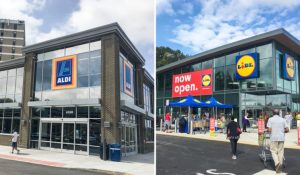
NPR’s Alina Selyukh describes how German grocers Aldi and Lidl are changing the way Americans shop in both urban and suburban markets. Their compact foot prints and stream-lined service and merchandise fit well in compact, walkable communities, and offer lessons for American retailers in the changing retail climate:
“Both [Aldi and Lidl] stores are known particularly for private-brand, or store-label, products. Jim Hertel, senior vice president at food retail consultancy Inmar Willard Bishop Analytics, says that allows these grocers to offer customers savings of about 35-40 percent compared with other supermarkets. A limited stock goes into these discount stores, which are very compact and value efficiency above frills.
“Typically, in a grocery store you’d often find 25, 26, 27 aisles. In Lidl, what we do here is just six aisles,” says Lidl spokesman Will Harwood. “By the time a customer reaches the end of the first aisle, they’re going to typically be able to do about 80 percent of their shop.”
Hertel says there’s a common misconception that Aldi stores are geared toward low-income shoppers on very limited food budgets. “It’s really a combination,” he says. “Certainly, the extreme value does … appeal to the lower end of the economic scale, but actually the bulk of their sales come from mid- to maybe just above middle-class households.”